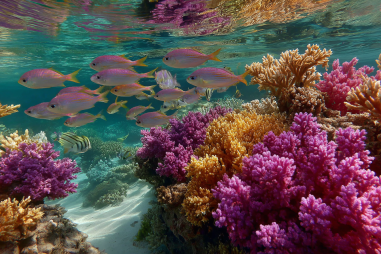The Philippines is renowned worldwide for its rich marine biodiversity and stunning coral reefs. One shining example of marine conservation efforts in the country is the Apo Island Marine Sanctuary. This protected area has become a model for successful community-driven marine preservation. In this article, we will explore some fascinating facts about the Apo Island Marine Sanctuary, its history, the diverse marine life it shelters, and the vital role it plays in both environmental conservation and local livelihoods.
Introduction to Apo Island Marine Sanctuary
Apo Island Marine Sanctuary is located off the coast of Negros Oriental in the central Philippines. Known for its vibrant coral reefs and abundant marine species, it covers approximately 450 hectares of protected marine habitat. The sanctuary attracts divers, snorkelers, and nature enthusiasts from around the world who come to experience the breathtaking underwater world. More than just a tourist attraction, it is a living testament to the success of community-based marine protection, balancing ecological preservation with sustainable local livelihoods.
History and Establishment of the Sanctuary
Established in 1982, the Apo Island Marine Sanctuary was one of the first community-driven marine protected areas (MPAs) in the Philippines. Before its establishment, overfishing and destructive fishing practices were threatening the health of the coral reefs and marine species around the island. Recognizing the ecological and economic importance of preserving their marine resources, the local community, with help from marine scientists and government agencies, initiated the creation of a no-fishing zone.
This initiative began with simple but powerful local regulations: fishing was prohibited within designated sanctuary boundaries to allow fish populations and coral reefs to recover. The community also developed rules for sustainable fishing and marine resource management outside the sanctuary zones. Over the years, the sanctuary has grown stronger and continues to thrive because of strict enforcement and unwavering community support.
Key Conservation Goals and Achievements
The primary goal of the Apo Island Marine Sanctuary is to protect and restore coral reef ecosystems and maintain a healthy marine environment that supports biodiversity and sustainable fisheries. In achieving this, the sanctuary serves several important functions:
- Rehabilitation of coral reefs – allowing damaged reefs to regenerate naturally.
- Increase in fish populations – providing safe breeding grounds and nursery habitats.
- Enhance biodiversity – preserving various species of fish, corals, and marine invertebrates.
- Support sustainable fishing practices – ensuring the community derives long-term benefits.
- Promote environmental education and awareness – engaging locals and visitors alike.
Since its inception, the sanctuary has prevented habitat destruction, significantly increased fish biomass and species richness, and enhanced the overall health of the reef ecosystem. It has become a blueprint for marine conservation efforts not just in the Philippines but globally.
Marine Species Protected in the Area
Apo Island’s waters are home to an extraordinary variety of marine life. The sanctuary protects numerous species of corals, fish, and other marine organisms. Some of the notable species found here include:
- Hard and soft corals: The coral reef around Apo Island supports nearly 650 species of hard corals and an array of soft corals that create diverse reef formations.
- Fish species: Over 400 species, including colorful reef fishes like clownfish, angelfish, butterflyfish, groupers, and parrotfish inhabit the sanctuary.
- Sea turtles: Green sea turtles and hawksbill turtles are commonly sighted, as the area provides important feeding grounds for these endangered species.
- Invertebrates: Various species of sea stars, giant clams, sea urchins, and crustaceans thrive in the sanctuary’s reefs and surrounding waters.
Many of these species are indicators of a healthy marine environment, and their presence shows the success of the sanctuary’s protection efforts.
Community Involvement and Eco-Tourism Benefits
The success of the Apo Island Marine Sanctuary is largely attributed to the active involvement of the local community. The island’s fisherfolk and residents were instrumental in establishing and managing the sanctuary. They have taken ownership of the protection efforts, monitoring the area, enforcing no-take zones, and educating visitors and younger generations about marine conservation.
Eco-tourism plays a crucial role in providing sustainable income to the local community. Tourist arrivals for snorkeling and diving generate revenue that supports local livelihoods, including accommodation, guiding services, and handicrafts. This economic incentive encourages the community to continue protecting the marine environment rather than resorting to destructive fishing methods.
The community also runs educational programs targeting both tourists and locals to raise awareness about marine ecology and conservation methods, strengthening the sanctuary’s long-term sustainability.
Visitor Guidelines to Support Preservation
To maintain the sanctuary’s health, visitors must follow strict guidelines designed to minimize environmental impact, including:
- Respecting no-fishing zones to allow fish populations to thrive.
- Not touching or stepping on corals, which are fragile and take years to grow.
- Avoiding littering or pollution by properly disposing of waste.
- Using reef-safe sunscreen products to prevent harmful chemicals from damaging corals.
- Following instructions from local guides to ensure responsible snorkeling and diving practices.
- Limiting group sizes and times in sensitive areas to reduce stress on marine life.
Following these guidelines helps ensure that future generations can also enjoy the pristine marine ecosystems of Apo Island.
Challenges and Future Outlook
Despite its successes, Apo Island Marine Sanctuary continues to face challenges. Increasing tourism, climate change, and occasional illegal fishing activities pose threats to the delicate balance of the marine ecosystem.
Coral bleaching events caused by rising sea temperatures affect coral health, requiring ongoing monitoring and adaptive conservation strategies. Additionally, balancing the growth of tourism with environmental sustainability calls for careful management to prevent habitat degradation.
Future efforts are focused on strengthening community enforcement, expanding marine protection areas, implementing climate adaptation measures, and enhancing environmental education and research. With continued vigilance and cooperation, the sanctuary hopes to remain a vibrant marine ecosystem and a model for marine conservation.
Why Marine Sanctuaries Like Apo Island Matter
Marine sanctuaries such as Apo Island play a vital role in preserving the planet’s biodiversity, maintaining healthy fisheries, and supporting coastal communities. They act as natural buffers against storms and erosion, protect endangered species, and provide opportunities for scientific research and sustainable tourism.
Apo Island Marine Sanctuary exemplifies how integrating community stewardship with conservation goals can lead to lasting positive impacts on both people and nature. Its ongoing success story inspires similar efforts worldwide, underscoring the importance of protecting our ocean treasures today for a sustainable tomorrow.







